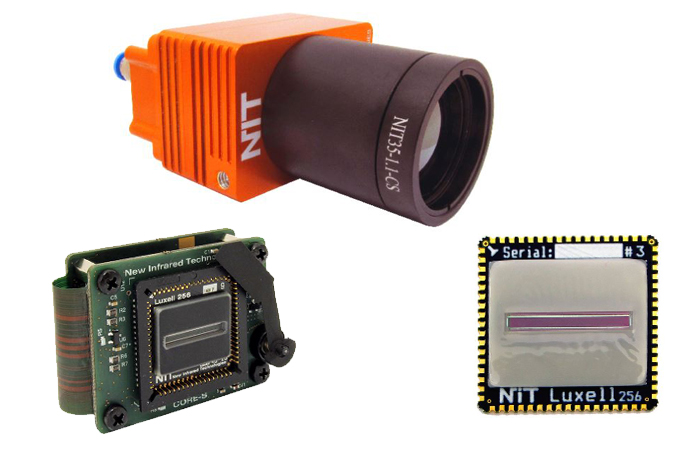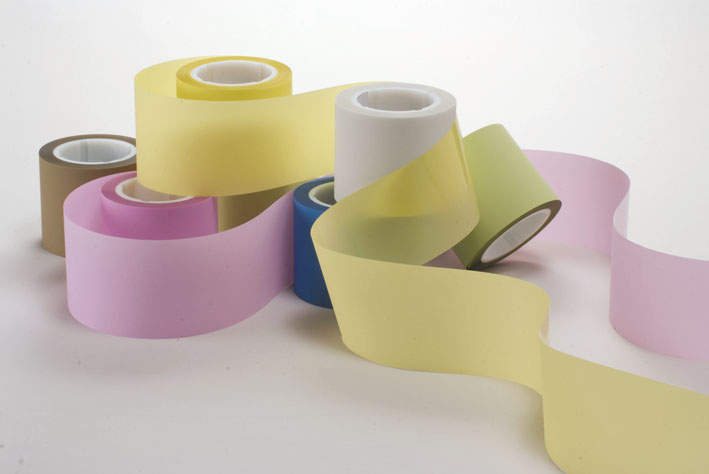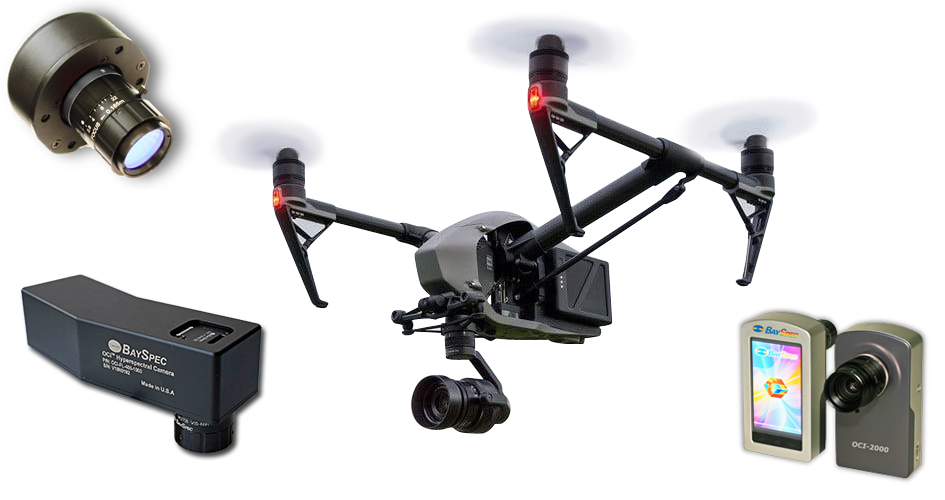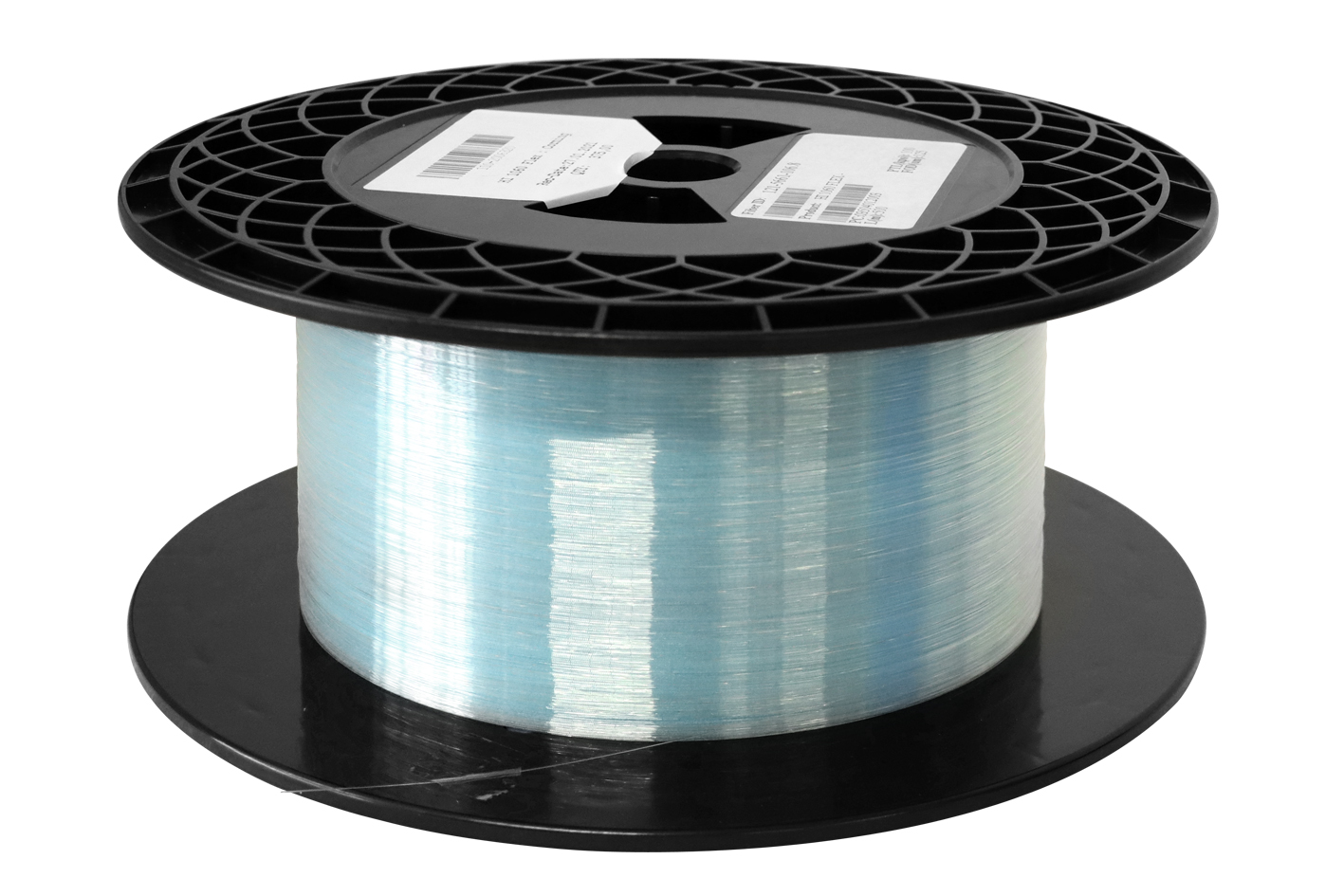OCI™ Series Hyperspectral Imagers
400-1700 nm; 12-240 Spectral Bands; Push-broom, Snapshot Operation Mode; Spectral Resolution 3-15 nm FWHM; Max. Frame Rate 8-120 fps; Standard Lens 16, 35, 45 mm (21°, 18°, 17° FOV)
Within its OCI™ Series of hyperspectral imagers (OCI is a phonetic spelling of "all seeing eye"), BaySpec offers systems ranging from miniaturized push-broom cameras for visible to near-infrared (NIR) to handheld snapshot hyperspectral imagers, hyperspectral cameras designed specifically for use on unmanned aerial vehicles/systems (UAV/UAS), all the way to ready-to-fly UAV systems for aerial hyperspectral imaging.
OCI™ F Series cameras are miniaturized (14 x 7 x 7 cm) and lightweight (~570 g) push-broom hyperspectral cameras covering the full visible (VIS) to near-infrared (NIR) wavelength range from 400 to 1000 nm, or short-wave infrared (SWIR) wavelength range from 900 to 1700 nm. The cameras feature a super-speed USB 3.0 interface for fast data transfer rates up to 60 fps. Not dependent on a constant scanning speed, the OCI F Series offers versatility on various platforms such as UAVs with perfect hyperspectral image stitching. Three models with 60, 120 or 240 spectral bands are available.
The OCI™-2000 snapshot handheld hyperspectral imager brings high-performance hyperspectral imaging in a handheld form factor weighing only approximately 450 g. The OCI™-2000 imager acquires full, continuous VIS to NIR hyperspectral/multispectral data with simple point-and-shoot operation.
Compact OCI™-OEM hyperspectral cameras are the optical engines of the handheld OCI-1000™ (push-broom) and OCI-2000™ (snapshot) hyperspectral imager, featuring extreme compactness and fast data transfer rate. The high-performance hyperspectral/multispectral cameras work in push-broom mode (OCI™-U-1000) or snapshot mode (OCI™-U-2000) with high spectral resolution and fast speed in a compact form factor weighing less than 180 g. Continuous hyperspectral data capturing can happen at video rates. Compactness, simple operation and optional SDK makes the OCI™-OEM integration an effortless task.
OCI™-UAV airborne hyperspectral cameras are push-broom (OCI™-UAV-1000) or snapshot (OCI™-UAV-2000) cameras designed specifically for use on unmanned aerial vehicles/systems (UAV/UAS), or remotely operated vehicles (ROV). Packed with a high-performance, miniature single-board-computer, they acquire VIS to NIR hyperspectral data with continuous spectral and spatial coverage. Ready-to-fly hyperspectral total solutions are also available. Operating of the OCI-UAV cameras is automatic and requires minimal human intervention.
The OCI™-M+, a push-broom multispectral imager is specifically designed for aerial imaging, featuring a lightweight camera with compact size. It comes with 12 selective bands including three RGB bands, and nine spectral bands from red edge to NIR – most commonly used for precision agriculture. This imager is fully integrated with DJI Inspire 2 UAV allowing the maximum field coverage with high spatial resolution (4000 spatial pixels). Fully integrated and easy to operate, the OCI-M+ UAV ready-to-fly package has made aerial imaging process very straightforward, and is ideal for applications such as precision agriculture, remote sensing, and geological survey.
BaySpec’s OCI™-D airborne VIS-NIR hyperspectral imager with extended wavelength range covers full VIS-NIR wavelength range from 475 to 975 nm. Being a snapshot hyperspectral imager, OCI-D2000 fundamentally eliminates artifacts caused by motions during flight. These innovations significantly reduce the requirements on UAV system, so that integration is almost effortless for many UAV/ROVs. Included with BaySpec’s SpecGrabber™ for camera control and data acquisition, and CubeCreator™ for hyperspectral data processing, the OCI™-D imager offes up to 40 spectral bands with 500x250 pixels and 12 to 15 nm resolution with video rate speed.
Key Features:
Full Visible (VIS) to Near-infrared (NIR) Coverage: 400 (450, 600) to 1000 nm
Full Short-wave Infrared (SWIR) Coverage: 900 to 1700 nm (OCI™-F-SWIR Hyperspectral Camera)
Operation Mode: Push-broom, Snapshot
Number of Spectral Bands: 12 to 240
Spectral Resolution: 3 nm to 15 nm FWHM
Spatial Pixels: 250 to 3956 Pixels x Scan Length (Push-broom Models), Up to 400 x 200 Pixels (Snapshot Models)
Standard Lens: 16 mm (21° FOV, OCI™ F Series), 35 mm (18° FOV, OCI™-UAV, OCI™-OEM Series), 45 mm (17° FOV, OCI™-M+)
Objective Lens Interface: C-Mount
Faster Scanning With Wide-angle Lens (OCI™-M+)
Exposure Time: 20 µs to 1 s (OCI™ F Series, OCI™-M+), 0(1) to 300 ms (OCI™-UAV, OCI™-OEM Series)
Max. Frame Rate: 8 to 120 fps
Camera Interface: USB 3.0, USB 2.0
Real‐time Sample Preview (OCI™ F, OCI™-M+, OCI™-UAV, OCI™-OEM Series)
Extremely Compact and Lightweight
Imagers With No Moving Parts, High Reliability
“True Push‐broom” Scanning With Random Speed (Push-broom Models Only)
Innovative Non-slit Design Significantly Reduces System Complexity (OCI™-M+, OCI™-UAV, OCI™-OEM)
Extremely Easy-to-use Point-and-shoot Hyperspectral Imager; Self-contained System With Touchscreen Computer Integrated in a Handheld Form; Choice of Lenses for Different FOV (OCI™-2000)
Easy Integration in a Variety of Platforms (OCI™ F, OCI™-UAV, OCI™-OEM, OCI™-D Series)
Effortless System Integration (OCI™-M+, OCI™-OEM Series)
Eliminate Costly GPS/INS Orthorectification Post Processing
Yields Distortion-free Hyperspectral Band Images
Ready-to-fly System (OCI™-M+, OCI™-UAV)
UAV (OCI™-M+): DJI Inspire 2; 22 min Flying Time; Remote Controller, Battery, Charger, CineSSD & Station Included
UAV (OCI™-UAV Series): 700 mm Multi-rotor, Shock-resistant Light Polymer Frame; Up to 20 min Flying Time; Automatic Flight Control Via Mission Planner; Autopilot, 2 x 4500 mAH LiPo Battery, Gimbal for Imager Included
Applications: Precision Agriculture; Food Quality Sorting; Sorting; Airborne (Mini) UAV/ROV; Remote Sensing; Chemical Detection; Process Control; Counterfeit Detection & Anti‐Counterfeiting; (Bio)medical Diagnostics; Forensics; Pharmaceuticals; Security; Defense; Oceanography; Ocean Monitoring; Forestry; Estuary Monitoring; Bathymetry; Mineral Discovery; Mining; Oil & Gas Exploration; Geological Survey; Ground Survey; Environmental Studies; Law Enforcement; Handheld Spectroscopy; Tissue Diagnostics; OEM Systems
Product number:
SW11753
Manufacturer:








